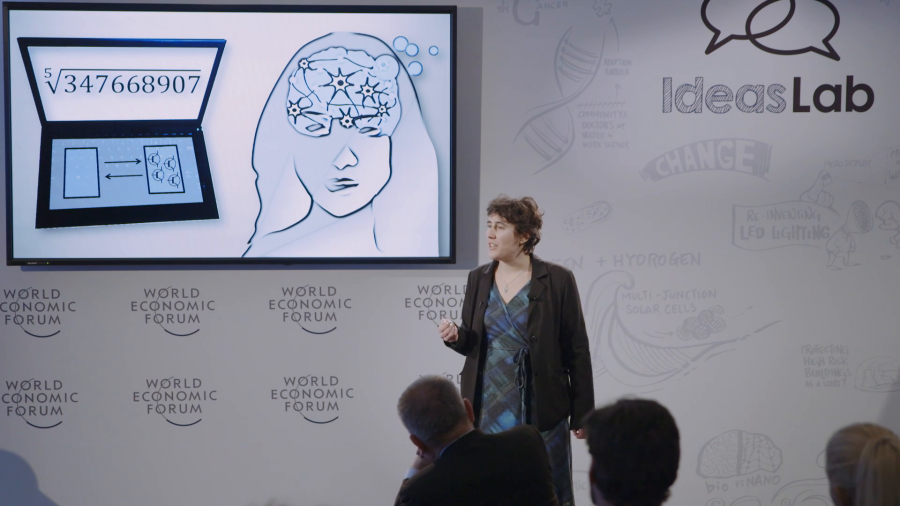Technology can help to build small computers inspired from the brain, and so here is the motivation for my work. Making our processors smaller and faster has turned them into energy ogres. If we were to increase their speed, they would self-destruct, heating locally as much as a nuclear reactor.
If we want to continue increasing the performance of our computers, we need to rethink the way we compute. And our brains are wonderful proof that impressive computations can be carried out with a very low power budget. We are able to recognize people we barely know in just a fraction of a second, and we do this much faster than any supercomputer while consuming one thousand times less power. Therefore it is very relevant to take inspiration from our brain to build fast and energy-efficient cognitive computing hardware.
But then, what is the difference between our brains and our computers? Well, everything. Their building blocks, their architecture, and their principles of computation are different. Our processors are made of billions of transistors. So inside, memory and processing are spatially separated. And data is continuously transported back and forth, which consumes a lot of power. In addition, our computers are sequential. They do mostly one thing at a time, slowing them down.
In comparison, in the brain, there are a hundred billion neurons and one thousand times more synapses. Memory, provided by the synapses, is entangled with the processing provided by neurons, which all work in parallel. And so this entanglement and this parallel processing are two reasons the brain is low-power and fast.
So, our computers are excellent at precise arithmetic. Our brains excel at cognitive tasks. So how can we build cognitive hardware that will be compatible with our current computers? How can we catch the essence of biological synapses and neurons, and map it to hardware?
For synapses, there is some consensus. We know that it is very important to reproduce their plasticity. In other words, their ability to reconfigure the strength with which they connect to neurons. Indeed, we know that it is this plasticity that allows memories to be formed and to be stored in the brain. So a chip with plastic synapses could learn and adapt to the changing world. For example, the exact same chip could learn to detect diseases if provided with medical information, or to detect traces of pollutants if provided with water composition. This would be very useful.
So, how can we fabricate electronic nano-synapses, and [not] research plasticity? It is very inefficient to implement these properties with transistors. There are some substantial efforts to develop novel materials and novel physics to emulate artificial nano-synapses. The best solution today are nano-resistors called “memristors.” These nano-fuses can regulate the electrical current flow between between two neurons. If they let a lot of current flow, the synapse is active and a memory is imprinted. If they let just a trickle of current flow, the synapse is inactive.
Researchers know how to fabricate tens of these memristors. But the challenge is to build dense arrays of hundreds of millions of these artificial nano-synapses, and to connect them to electronic neurons. And the main trend today to fabricate these electronic neurons is to assemble tens of transistors, which takes a lot of space on silicon.
So how can we fabricate nano-neurons? Well, the approach we are using in my laboratory is to devise tiny electronic oscillators. Indeed, the brain has its own rhythms, and we know that for some computations, neurons behave as small oscillators that vibrate differently depending on the signals incoming from other neurons. We want to build chips that can learn and process information through the complex vibrations of these electronic oscillators, coupled with memristor synapses.
Are you familiar with djembes, the African drums? Well, when the drummer strikes the edge or the center of the drum, the skin vibrates differently, producing a different sound. So you could say that these drums are able to classify. By listening to the sound, which is a result a the computation, you can know if the drummer has struck the center or somewhere around the edge. So, our chips would work in a similar way, but with nanotechnology and producing much more complex and crazy vibrations, allowing much more computing power.
So, this is a field of research that is still in its infancy. But if we succeed, we could make sense of Big Data with a very low energy cost. We could give robots a small embedded brain, to make them more autonomous. And we could build smart prostheses for medical applications. And in addition, by trying to build systems inspired from the brain, we could learn more about the brain itself.
So the question I would like to ask you today is, what would you do? How can you use in your everyday life or in your business, a small chip that can do powerful pattern recognition with a very low power budget?
Thank you.
